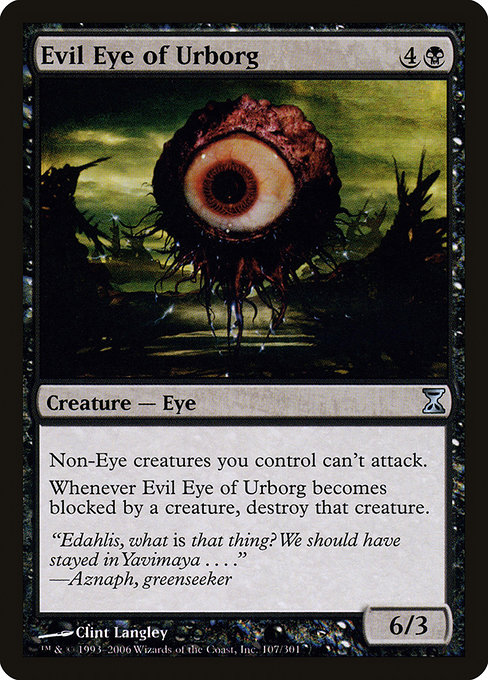
Image courtesy of Scryfall.com
Design Intent Behind Evil Eye of Urborg’s Subtle Effect
In the shadowed corners of Time Spiral, Wizards of the Coast stitched a design that sounds almost paradoxical at first glance: a powerhouse black creature that also quietly invites restraint from its own side. Evil Eye of Urborg costs 4 generic and one black mana (4B) for a potent 6/3 body that carries a pair of game-defining abilities. On the surface, this is a big-eye monster that looks like it belongs in a black-tinged combat zone. But the card’s real cleverness lies in its two linked design levers: a gating effect that prevents non-Eye creatures you control from attacking, and a built-in deterrent against the first blocker that dares to challenge it. Together, they craft a strategic narrative where aggression isn’t about flooding the board but about controlling the terms of engagement. 🧙♂️🔥 This subtle restraint mirrors core black themes—control, punishment, and the psychology of threat assessment. The mana tax (a hefty five mana total) paired with a 6/3 presence is enough to demand respect in combat, but the gating clause—“Non-Eye creatures you control can't attack”—asks players to think beyond brute force. Deck builders are nudged toward a more deliberate approach: you don’t swing with just anything; you curate an "Eye" cadre that can threaten opponents while preserving the option to push aggression when it matters. The effect becomes a narrative tool as well as a mechanical one. When you lay this creature down, your opponents suddenly recalibrate their attack plans, wondering if your Eye is a snare or a beacon drawing them into a calculated trap. ⚔️ The second line, “Whenever this creature becomes blocked by a creature, destroy that creature,” is the real engine of the card’s drama. It converts combat into a two-step dance: first, the Eye enters a confrontation that you’ve already pre-signed as favorable (or at least worth the risk), and then the moment any blocker appears, that blocker is obliterated. The design thus rewards players who can choreograph battles—using evasive threats to force blocks, then watching as the Eye tears through the defense. It’s not a mass removal spell in disguise; it’s a disciplined, battlefield-level payoff that emphasizes timing and positional play. The flavor text—“Edahlis, what is that thing? We should have stayed in Yavimaya . . . .”—echoes the sense of creeping dread that accompanies a force that both dissuades and punishes overreach. The card’s identity as an “Eye” creature is not just punny wordplay; it’s a narrative cue for players to lean into a theme of watchful sovereignty over a deadly maze of weak spots. 💎 From a design perspective, the Time Spiral era is famous for time-warp introductions and cross-ploating ideas. Evil Eye of Urborg embodies that spirit by juxtaposing an aggressive stat line with a strategic constraint. The set’s motif of retrospective, paradoxical power fits neatly with a card that looks like a straightforward beater but actually depends on a careful maintenance of a specific creature type on your battlefield. The result is a memorable, almost archetypal boss for black midrange or control-oriented builds. It’s a reminder that power isn’t only about raw numbers; it’s about the architecture of risk, restraint, and opportunistic removal. 🔮 For players thinking about construction today, Evil Eye of Urborg invites a particular rhythm. You want to maximize the synergy of “Eye” creatures—if you lean into a theme where your board state can sustain multiple Eye threats, you get a perpetual pressure cooker where opponents must decide how to commit to combat. Meanwhile, the fearsome destruction of the blocking creature ensures your Eye can survive and strike back, turning a stalemate into a decisive tempo swing. In modern formats where you can pull the Eye into a larger ecosystem of resilient and evasive threats, the card’s philosophy still resonates: attack on your terms, punish hesitation, and let the board state tilt in your favor as the late-game pressure builds. 🧙♂️ If you’re a collector or a casual observer, the card’s rarity, and its foil-versus-nonfoil dynamic, adds a layer of value and charm. In Time Spiral, this uncommon black behemoth sits among a mosaic of time-shifted designs that reward careful reading and patient play. The art, by Clint Langley, captures a gaze that seems to bore through the battlefield—an illustration that echoes the card’s intention: a sentinel that makes opponents measure every move. The foil version, with a higher market price, remains a sought-after piece for showy Commander boards or a nostalgic nod to the era’s inventive design language. As with many legendary-looking individuals in the MTG pantheon, Evil Eye of Urborg rewards players who delight in the story of a card that speaks as loudly through its rules text as it does through its silhouette on the battlefield. ⚔️🎨 As you consider modern deck design and casual play, think about how a single line of text can reframe a game’s tempo. The Eye’s ability to restrict attacking creatures you control to Eye types is a provocative constraint—one that pushes you to cultivate a roster that sings as a chorus rather than a solo performance. It’s a design choice that invites experimentation, and that’s exactly the kind of invitation that keeps the MTG multiverse vibrant and full of possibility. 🧙♂️Looking for a modern companion to your tabletop hobby? A sleek neon card holder phone case can be a stylish, portable nod to the way we often carry around our favorite spells and creatures. It’s a small bridge between the tactile joy of the game and the everyday practicality of life between matches. The product below pairs nicely with the fanatic energy of spending a Thursday night refining a nerfed-but-noble Eye deck.
Neon Card Holder Phone Case MagSafe – Impact Resistant PolycarbonateMore from our network
- https://crypto-acolytes.xyz/blog/post/exploring-minecraft-esports-potential-a-competitive-frontier/
- https://transparent-paper.shop/blog/post/realistic-shadow-mapping-on-digital-paper-layers/
- https://crypto-acolytes.xyz/blog/post/top-minecraft-discord-servers-for-builders-and-adventurers/
- https://crypto-acoly.xyz/blog/post/quantum-computing-and-crypto-security-navigating-a-post-quantum-world/
- https://crypto-acoly.xyz/blog/post/minecraft-elytra-flight-fireworks-tips-and-tricks/